SPOR60751 Report: High and Low Bar Jump Squat Test Comparison
VerifiedAdded on 2023/04/21
|13
|3264
|479
Report
AI Summary
This report presents a comparative analysis of high bar (HB) and low bar (LB) jump squats, focusing on outcome measures such as jump height, time, maximum force, peak power, total work, and rate of force development (RPD). The study involved university students performing both HB and LB jump squats on a force plate, with data collected across multiple trials. The results, analyzed using Excel, revealed differences in outcome measures between the two types of squats, with HB jump squats generally exhibiting greater jump height, peak power, total work, and RPD compared to LB jump squats. The discussion highlights the influence of technique and muscle kinematics on these results. The study underscores the importance of proper exercise technique for achieving optimal benefits and minimizing injury risk. The report also provides data tables and graphs to illustrate the findings.

Running head: HIGH AND LOW BAR JUMP SQUAT TEST
COMPARISON OF OUTCOME MEASURES OF HIGH AND LOW BAR JUMP SQUATS
Name
Course
Professor
University
City/state
Date
Word count: 2,138
COMPARISON OF OUTCOME MEASURES OF HIGH AND LOW BAR JUMP SQUATS
Name
Course
Professor
University
City/state
Date
Word count: 2,138
Paraphrase This Document
Need a fresh take? Get an instant paraphrase of this document with our AI Paraphraser
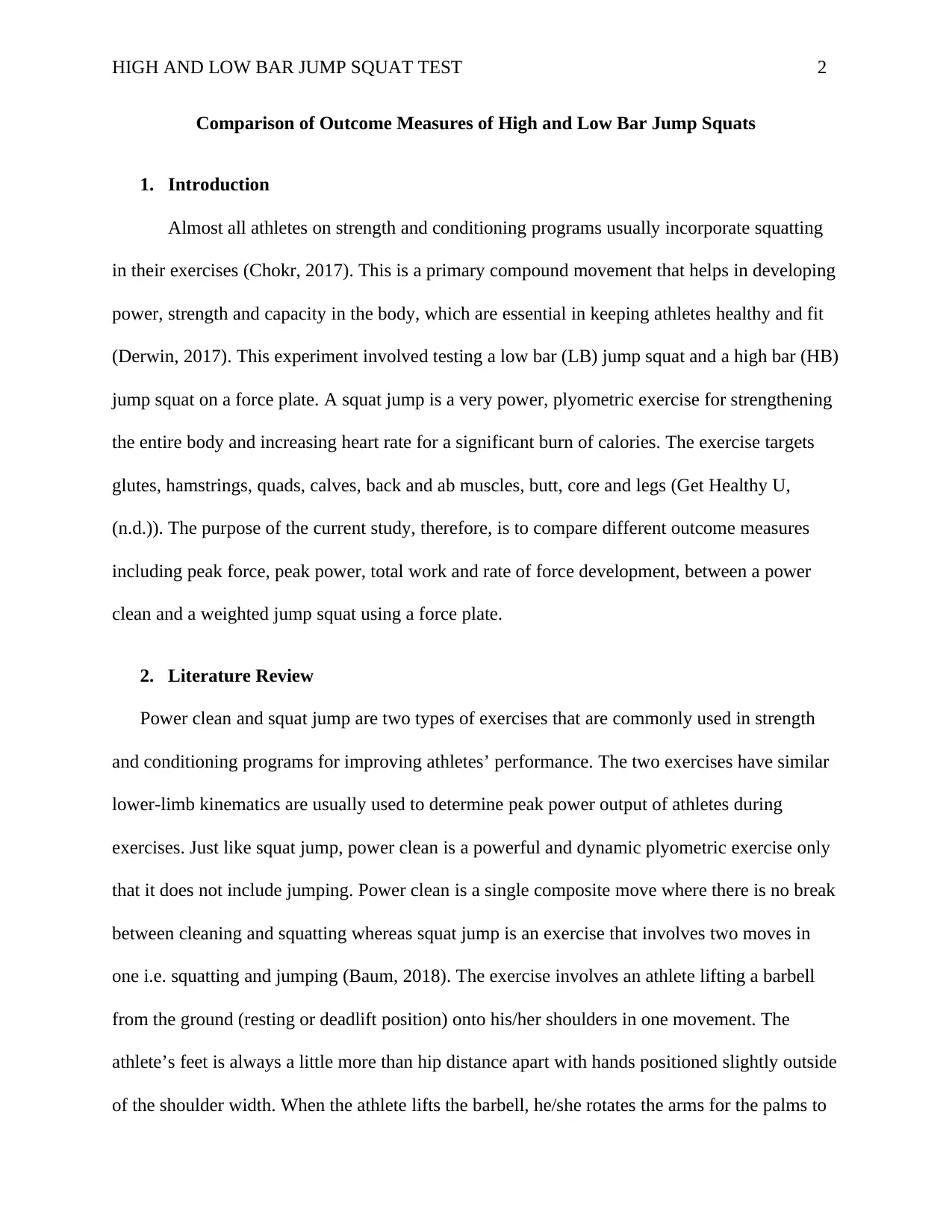
HIGH AND LOW BAR JUMP SQUAT TEST 2
Comparison of Outcome Measures of High and Low Bar Jump Squats
1. Introduction
Almost all athletes on strength and conditioning programs usually incorporate squatting
in their exercises (Chokr, 2017). This is a primary compound movement that helps in developing
power, strength and capacity in the body, which are essential in keeping athletes healthy and fit
(Derwin, 2017). This experiment involved testing a low bar (LB) jump squat and a high bar (HB)
jump squat on a force plate. A squat jump is a very power, plyometric exercise for strengthening
the entire body and increasing heart rate for a significant burn of calories. The exercise targets
glutes, hamstrings, quads, calves, back and ab muscles, butt, core and legs (Get Healthy U,
(n.d.)). The purpose of the current study, therefore, is to compare different outcome measures
including peak force, peak power, total work and rate of force development, between a power
clean and a weighted jump squat using a force plate.
2. Literature Review
Power clean and squat jump are two types of exercises that are commonly used in strength
and conditioning programs for improving athletes’ performance. The two exercises have similar
lower-limb kinematics are usually used to determine peak power output of athletes during
exercises. Just like squat jump, power clean is a powerful and dynamic plyometric exercise only
that it does not include jumping. Power clean is a single composite move where there is no break
between cleaning and squatting whereas squat jump is an exercise that involves two moves in
one i.e. squatting and jumping (Baum, 2018). The exercise involves an athlete lifting a barbell
from the ground (resting or deadlift position) onto his/her shoulders in one movement. The
athlete’s feet is always a little more than hip distance apart with hands positioned slightly outside
of the shoulder width. When the athlete lifts the barbell, he/she rotates the arms for the palms to
Comparison of Outcome Measures of High and Low Bar Jump Squats
1. Introduction
Almost all athletes on strength and conditioning programs usually incorporate squatting
in their exercises (Chokr, 2017). This is a primary compound movement that helps in developing
power, strength and capacity in the body, which are essential in keeping athletes healthy and fit
(Derwin, 2017). This experiment involved testing a low bar (LB) jump squat and a high bar (HB)
jump squat on a force plate. A squat jump is a very power, plyometric exercise for strengthening
the entire body and increasing heart rate for a significant burn of calories. The exercise targets
glutes, hamstrings, quads, calves, back and ab muscles, butt, core and legs (Get Healthy U,
(n.d.)). The purpose of the current study, therefore, is to compare different outcome measures
including peak force, peak power, total work and rate of force development, between a power
clean and a weighted jump squat using a force plate.
2. Literature Review
Power clean and squat jump are two types of exercises that are commonly used in strength
and conditioning programs for improving athletes’ performance. The two exercises have similar
lower-limb kinematics are usually used to determine peak power output of athletes during
exercises. Just like squat jump, power clean is a powerful and dynamic plyometric exercise only
that it does not include jumping. Power clean is a single composite move where there is no break
between cleaning and squatting whereas squat jump is an exercise that involves two moves in
one i.e. squatting and jumping (Baum, 2018). The exercise involves an athlete lifting a barbell
from the ground (resting or deadlift position) onto his/her shoulders in one movement. The
athlete’s feet is always a little more than hip distance apart with hands positioned slightly outside
of the shoulder width. When the athlete lifts the barbell, he/she rotates the arms for the palms to

HIGH AND LOW BAR JUMP SQUAT TEST 3
face up and position the barbell by the shoulders while squatting the lower body. Depending on
the hip flexibility of the athlete and the weight of barbell being lifted, the reps can be started
from the ground or the barbell can also be placed at the shins. Some of the benefits of power
clean include: improved patterns and efficiency of movement, improved power and strength, and
improved mental toughness (Bosse, 2018).
There are two types of jump squat: low bar jump squat and high bar jump squat. These two
are among the exercises that have a huge impact on the overall strength and development of
many athletes (Pollack, 2018). High bar jump squat is performed when the bar is positioned
across the top of the shoulder above the trapezius muscles and behind the neck while low bar
jump squat is performed when the bar is positioned below the trapezius muscles (Glassbrook,
Helms, Brown, Duncan, & Storey, 2017).
There are numerous studies that have been conducted to compare different outcome measures
of power clean and jump squats, and other exercises such as push press and vertical jump. These
studies were conducted using trained participants who understood the right technique of
performing the exercises and also inexperienced athletes but they still provided reliable results.
Findings from majority of the studies show that power clean produces greater peak power, work
and rate of force development than jump squat (Comfort & McMahon, 2015); (Comfort, et al.,
2016).
For the potential benefits of power clean and squat jump to be realized, the exercises should
be practiced using the right technique. This means that the athlete should know when and how to
bend, lift the bar, receive the weight, drop under the weight, squat, release the weight and jump.
Therefore it is very important to learn the right technique of executing these exercises so as to
face up and position the barbell by the shoulders while squatting the lower body. Depending on
the hip flexibility of the athlete and the weight of barbell being lifted, the reps can be started
from the ground or the barbell can also be placed at the shins. Some of the benefits of power
clean include: improved patterns and efficiency of movement, improved power and strength, and
improved mental toughness (Bosse, 2018).
There are two types of jump squat: low bar jump squat and high bar jump squat. These two
are among the exercises that have a huge impact on the overall strength and development of
many athletes (Pollack, 2018). High bar jump squat is performed when the bar is positioned
across the top of the shoulder above the trapezius muscles and behind the neck while low bar
jump squat is performed when the bar is positioned below the trapezius muscles (Glassbrook,
Helms, Brown, Duncan, & Storey, 2017).
There are numerous studies that have been conducted to compare different outcome measures
of power clean and jump squats, and other exercises such as push press and vertical jump. These
studies were conducted using trained participants who understood the right technique of
performing the exercises and also inexperienced athletes but they still provided reliable results.
Findings from majority of the studies show that power clean produces greater peak power, work
and rate of force development than jump squat (Comfort & McMahon, 2015); (Comfort, et al.,
2016).
For the potential benefits of power clean and squat jump to be realized, the exercises should
be practiced using the right technique. This means that the athlete should know when and how to
bend, lift the bar, receive the weight, drop under the weight, squat, release the weight and jump.
Therefore it is very important to learn the right technique of executing these exercises so as to
⊘ This is a preview!⊘
Do you want full access?
Subscribe today to unlock all pages.

Trusted by 1+ million students worldwide

HIGH AND LOW BAR JUMP SQUAT TEST 4
achieve their expected benefits and also avoid injuries. Figure 1 and 2 below shows the right
techniques of performing jump squat and power clean exercises respectively.
Figure 1: Jump squat technique (Mackenzie, Lavers, & Wallace, 2014)
Figure 2: Power clean technique
3. Method
The test was conducted using both male and female university students. This group had three
participants Kris, Steve and Szilvia (myself). The participants had different familiarity and levels
of exercising techniques for jump squats. The exercises were performed using a squat rack and
barbell. The squat rack was set up in front of the force plate that recorded the required data. The
force plate was connected to the participant using surface electrodes. Before the start of the
exercise, the participants performed a dynamic warm up routine to prepare their muscles for the
exercise. The warm up lasted for about five minutes and it included dynamic stretches, body
weight squats, hip extensions, lunges, jumping jacks, jump rope, leg swings, leg crossovers, frog
walk-in, and hamstring stretch. Warm up is very important because it increases flow of blood
and oxygen in the body, increases movement range, increases power output and agility, improves
reaction time, reduces the risk of injury and increases performance (Elkaim, (n.d.)).
achieve their expected benefits and also avoid injuries. Figure 1 and 2 below shows the right
techniques of performing jump squat and power clean exercises respectively.
Figure 1: Jump squat technique (Mackenzie, Lavers, & Wallace, 2014)
Figure 2: Power clean technique
3. Method
The test was conducted using both male and female university students. This group had three
participants Kris, Steve and Szilvia (myself). The participants had different familiarity and levels
of exercising techniques for jump squats. The exercises were performed using a squat rack and
barbell. The squat rack was set up in front of the force plate that recorded the required data. The
force plate was connected to the participant using surface electrodes. Before the start of the
exercise, the participants performed a dynamic warm up routine to prepare their muscles for the
exercise. The warm up lasted for about five minutes and it included dynamic stretches, body
weight squats, hip extensions, lunges, jumping jacks, jump rope, leg swings, leg crossovers, frog
walk-in, and hamstring stretch. Warm up is very important because it increases flow of blood
and oxygen in the body, increases movement range, increases power output and agility, improves
reaction time, reduces the risk of injury and increases performance (Elkaim, (n.d.)).
Paraphrase This Document
Need a fresh take? Get an instant paraphrase of this document with our AI Paraphraser

HIGH AND LOW BAR JUMP SQUAT TEST 5
After the warm up, the participants were given instructions on how to unrack the bar, get into
the right position and perform the jump squat. But before the jumps, the bar height was
measured. Each participant performed three trials for high bar jump squat and another three trials
for low bar jump squat, with three minutes rest between trials. The participants completed the
jump squat trials by incorporating a countermovement where they were instructed to squat to the
depth where they felt they could jump easily to the greatest height in a single, smooth down/up
motion. The data recorded by the force plate was used to calculate jump height, maximum or
peak power, maximum force, total work and rate of force development (RPD).
4. Results
Results of three trials for each participant were recorded and analyzed in Excel. The
summary of results are provided in Appendix 1 and 2. The results were used to draw graphs
showing the difference in outcome measures for low bar and high bar jump squats. The results
show that there was a difference in the three trials for each exercise and participant but the
difference between trials was small hence insignificant. The results from the three trials were
used to determine the mean or average value for each outcome measure. The average values
were used for the statistical analysis in this report.
Figure 3 below shows the jump height recorded for the high bar and low bar jump squats. On
average, the jump height for high bar jump squat was greater than that for low bar jump squat.
After the warm up, the participants were given instructions on how to unrack the bar, get into
the right position and perform the jump squat. But before the jumps, the bar height was
measured. Each participant performed three trials for high bar jump squat and another three trials
for low bar jump squat, with three minutes rest between trials. The participants completed the
jump squat trials by incorporating a countermovement where they were instructed to squat to the
depth where they felt they could jump easily to the greatest height in a single, smooth down/up
motion. The data recorded by the force plate was used to calculate jump height, maximum or
peak power, maximum force, total work and rate of force development (RPD).
4. Results
Results of three trials for each participant were recorded and analyzed in Excel. The
summary of results are provided in Appendix 1 and 2. The results were used to draw graphs
showing the difference in outcome measures for low bar and high bar jump squats. The results
show that there was a difference in the three trials for each exercise and participant but the
difference between trials was small hence insignificant. The results from the three trials were
used to determine the mean or average value for each outcome measure. The average values
were used for the statistical analysis in this report.
Figure 3 below shows the jump height recorded for the high bar and low bar jump squats. On
average, the jump height for high bar jump squat was greater than that for low bar jump squat.
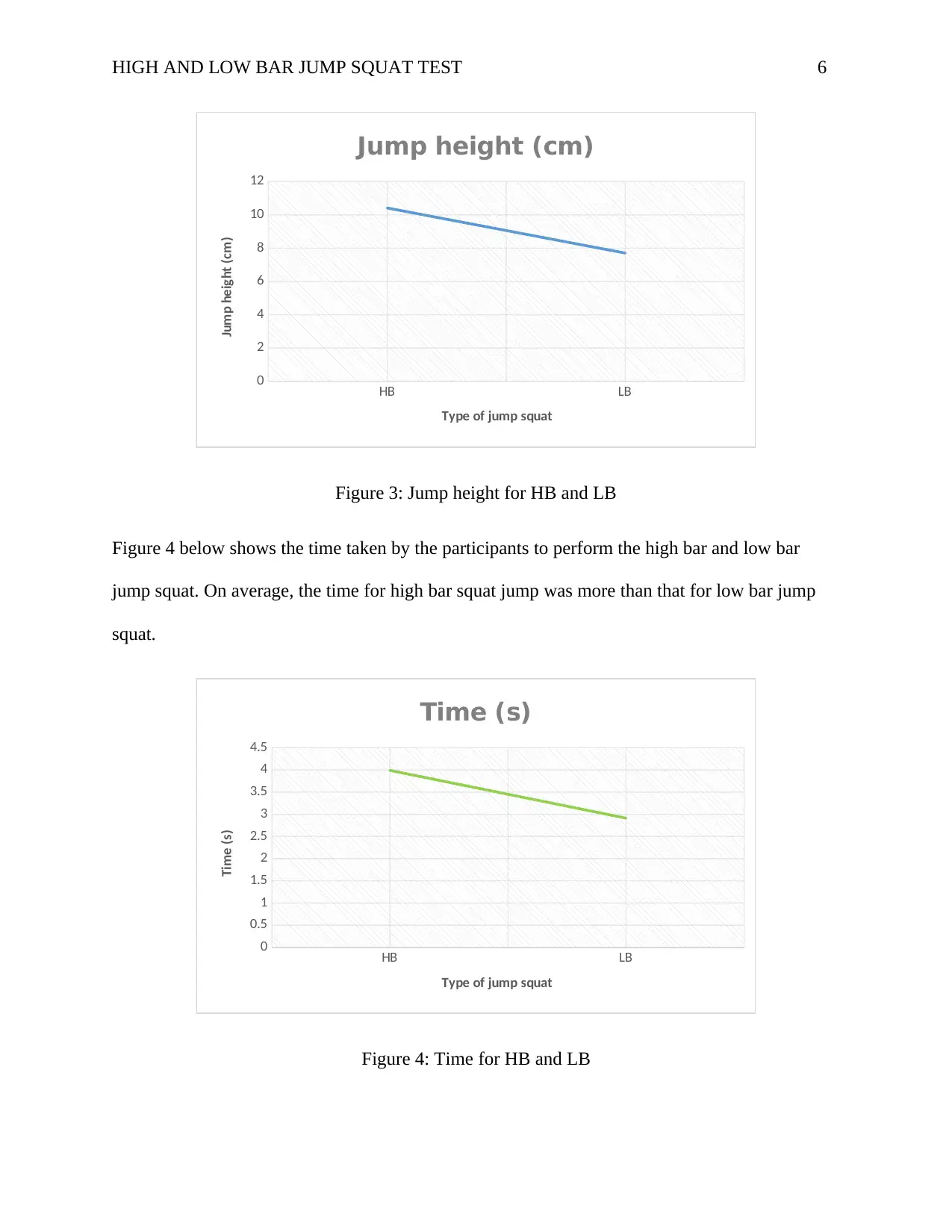
HIGH AND LOW BAR JUMP SQUAT TEST 6
HB LB
0
2
4
6
8
10
12
Jump height (cm)
Type of jump squat
Jump height (cm)
Figure 3: Jump height for HB and LB
Figure 4 below shows the time taken by the participants to perform the high bar and low bar
jump squat. On average, the time for high bar squat jump was more than that for low bar jump
squat.
HB LB
0
0.5
1
1.5
2
2.5
3
3.5
4
4.5
Time (s)
Type of jump squat
Time (s)
Figure 4: Time for HB and LB
HB LB
0
2
4
6
8
10
12
Jump height (cm)
Type of jump squat
Jump height (cm)
Figure 3: Jump height for HB and LB
Figure 4 below shows the time taken by the participants to perform the high bar and low bar
jump squat. On average, the time for high bar squat jump was more than that for low bar jump
squat.
HB LB
0
0.5
1
1.5
2
2.5
3
3.5
4
4.5
Time (s)
Type of jump squat
Time (s)
Figure 4: Time for HB and LB
⊘ This is a preview!⊘
Do you want full access?
Subscribe today to unlock all pages.

Trusted by 1+ million students worldwide

HIGH AND LOW BAR JUMP SQUAT TEST 7
Figure 5 below shows the maximum force for the high bar and low bar jump squat. On average,
the maximum force for the high bar squat jump was greater than that for low bar jump squat.
HB LB
2100
2200
2300
2400
2500
2600
2700
Max. force (N)
Type of jump squat
Max. Force (N)
Figure 5: Maximum force for HB and LB
Figure 6 below shows the peak power for the high bar and low bar jump squat. On average, the
peak power for the high bar squat jump was higher than that for low bar jump squat.
HB LB
0
500
1000
1500
2000
2500
3000
3500
Peak power
Type of jump squat
Peak power (W)
Figure 5 below shows the maximum force for the high bar and low bar jump squat. On average,
the maximum force for the high bar squat jump was greater than that for low bar jump squat.
HB LB
2100
2200
2300
2400
2500
2600
2700
Max. force (N)
Type of jump squat
Max. Force (N)
Figure 5: Maximum force for HB and LB
Figure 6 below shows the peak power for the high bar and low bar jump squat. On average, the
peak power for the high bar squat jump was higher than that for low bar jump squat.
HB LB
0
500
1000
1500
2000
2500
3000
3500
Peak power
Type of jump squat
Peak power (W)
Paraphrase This Document
Need a fresh take? Get an instant paraphrase of this document with our AI Paraphraser
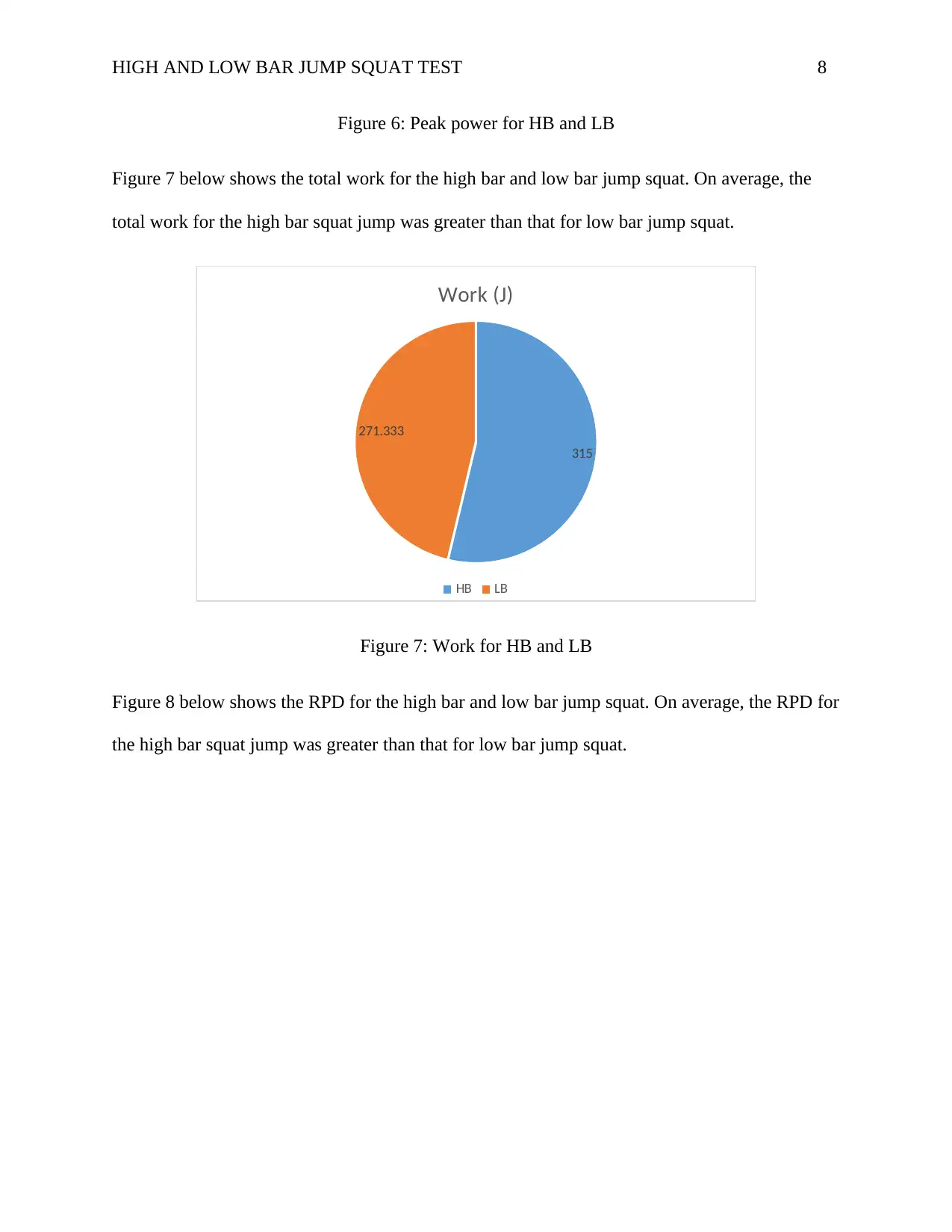
HIGH AND LOW BAR JUMP SQUAT TEST 8
Figure 6: Peak power for HB and LB
Figure 7 below shows the total work for the high bar and low bar jump squat. On average, the
total work for the high bar squat jump was greater than that for low bar jump squat.
315
271.333
Work (J)
HB LB
Figure 7: Work for HB and LB
Figure 8 below shows the RPD for the high bar and low bar jump squat. On average, the RPD for
the high bar squat jump was greater than that for low bar jump squat.
Figure 6: Peak power for HB and LB
Figure 7 below shows the total work for the high bar and low bar jump squat. On average, the
total work for the high bar squat jump was greater than that for low bar jump squat.
315
271.333
Work (J)
HB LB
Figure 7: Work for HB and LB
Figure 8 below shows the RPD for the high bar and low bar jump squat. On average, the RPD for
the high bar squat jump was greater than that for low bar jump squat.

HIGH AND LOW BAR JUMP SQUAT TEST 9
HB LB
0
5000
10000
15000
20000
25000
30000
RPD (W/s)
Type of jump squat
RPD (W/s)
Figure 8: RPD for HB and LB
All these results were similar to those of the other group members.
5. Discussion
Participants were not familiar with the exercise and therefore they did not use the right
technique to perform them. This resulted to less accurate results because using inappropriate
technique does not give the best results. The unfamiliarity also resulted to differences in data in
the three trials. However, the three trials done in each exercise were adequate to provide a
general representation of the results. That is why the average values of the three trials were used
in analyzing the findings of the experiment.
There was some different observed between the outcome measures for low bar and high bar
jump squats. However, this difference was small hence negligible and the reliability of results
from both exercises was high. The difference was as a result of the variance in kinematics of the
muscles involved in performing low bar jump squats and high bar jump squats.
HB LB
0
5000
10000
15000
20000
25000
30000
RPD (W/s)
Type of jump squat
RPD (W/s)
Figure 8: RPD for HB and LB
All these results were similar to those of the other group members.
5. Discussion
Participants were not familiar with the exercise and therefore they did not use the right
technique to perform them. This resulted to less accurate results because using inappropriate
technique does not give the best results. The unfamiliarity also resulted to differences in data in
the three trials. However, the three trials done in each exercise were adequate to provide a
general representation of the results. That is why the average values of the three trials were used
in analyzing the findings of the experiment.
There was some different observed between the outcome measures for low bar and high bar
jump squats. However, this difference was small hence negligible and the reliability of results
from both exercises was high. The difference was as a result of the variance in kinematics of the
muscles involved in performing low bar jump squats and high bar jump squats.
⊘ This is a preview!⊘
Do you want full access?
Subscribe today to unlock all pages.

Trusted by 1+ million students worldwide
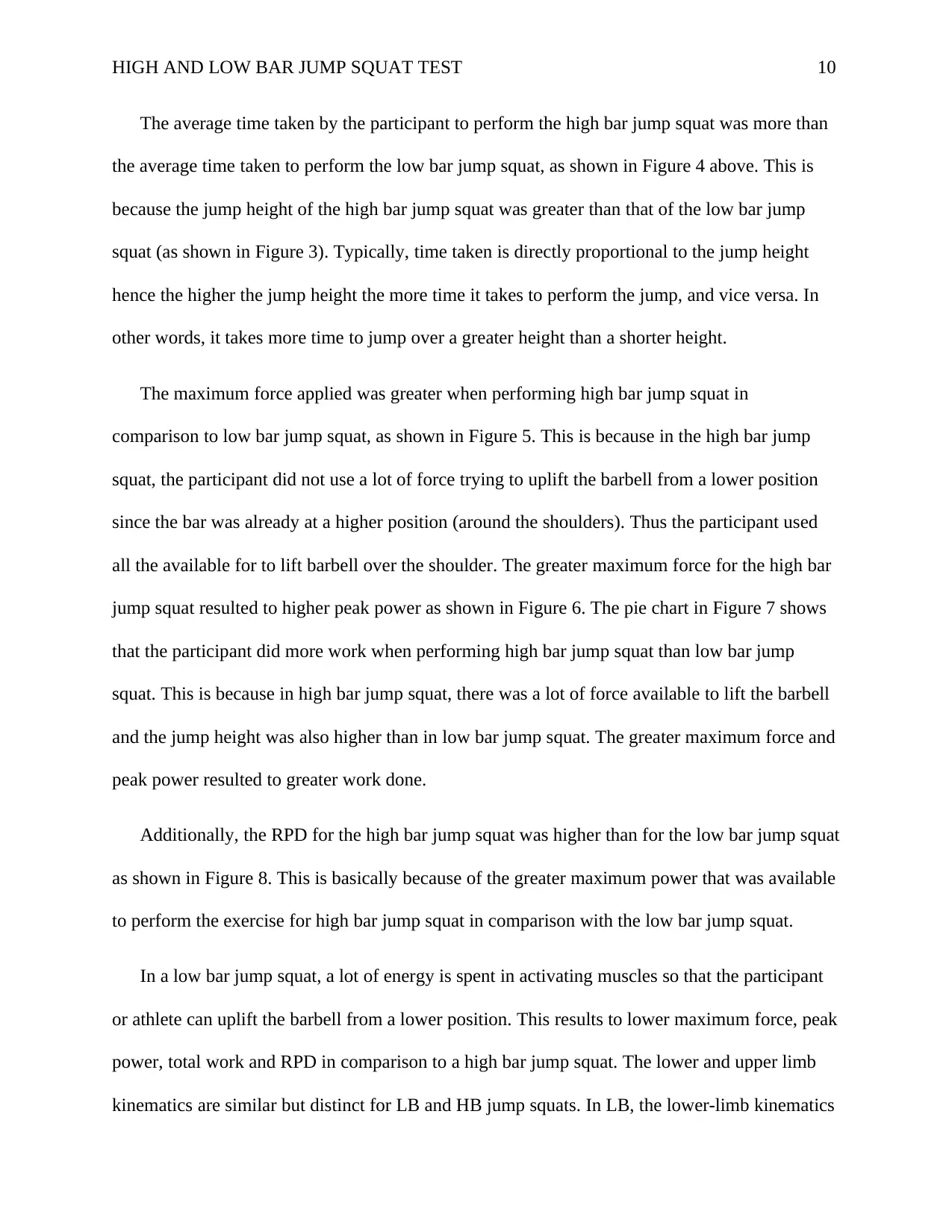
HIGH AND LOW BAR JUMP SQUAT TEST 10
The average time taken by the participant to perform the high bar jump squat was more than
the average time taken to perform the low bar jump squat, as shown in Figure 4 above. This is
because the jump height of the high bar jump squat was greater than that of the low bar jump
squat (as shown in Figure 3). Typically, time taken is directly proportional to the jump height
hence the higher the jump height the more time it takes to perform the jump, and vice versa. In
other words, it takes more time to jump over a greater height than a shorter height.
The maximum force applied was greater when performing high bar jump squat in
comparison to low bar jump squat, as shown in Figure 5. This is because in the high bar jump
squat, the participant did not use a lot of force trying to uplift the barbell from a lower position
since the bar was already at a higher position (around the shoulders). Thus the participant used
all the available for to lift barbell over the shoulder. The greater maximum force for the high bar
jump squat resulted to higher peak power as shown in Figure 6. The pie chart in Figure 7 shows
that the participant did more work when performing high bar jump squat than low bar jump
squat. This is because in high bar jump squat, there was a lot of force available to lift the barbell
and the jump height was also higher than in low bar jump squat. The greater maximum force and
peak power resulted to greater work done.
Additionally, the RPD for the high bar jump squat was higher than for the low bar jump squat
as shown in Figure 8. This is basically because of the greater maximum power that was available
to perform the exercise for high bar jump squat in comparison with the low bar jump squat.
In a low bar jump squat, a lot of energy is spent in activating muscles so that the participant
or athlete can uplift the barbell from a lower position. This results to lower maximum force, peak
power, total work and RPD in comparison to a high bar jump squat. The lower and upper limb
kinematics are similar but distinct for LB and HB jump squats. In LB, the lower-limb kinematics
The average time taken by the participant to perform the high bar jump squat was more than
the average time taken to perform the low bar jump squat, as shown in Figure 4 above. This is
because the jump height of the high bar jump squat was greater than that of the low bar jump
squat (as shown in Figure 3). Typically, time taken is directly proportional to the jump height
hence the higher the jump height the more time it takes to perform the jump, and vice versa. In
other words, it takes more time to jump over a greater height than a shorter height.
The maximum force applied was greater when performing high bar jump squat in
comparison to low bar jump squat, as shown in Figure 5. This is because in the high bar jump
squat, the participant did not use a lot of force trying to uplift the barbell from a lower position
since the bar was already at a higher position (around the shoulders). Thus the participant used
all the available for to lift barbell over the shoulder. The greater maximum force for the high bar
jump squat resulted to higher peak power as shown in Figure 6. The pie chart in Figure 7 shows
that the participant did more work when performing high bar jump squat than low bar jump
squat. This is because in high bar jump squat, there was a lot of force available to lift the barbell
and the jump height was also higher than in low bar jump squat. The greater maximum force and
peak power resulted to greater work done.
Additionally, the RPD for the high bar jump squat was higher than for the low bar jump squat
as shown in Figure 8. This is basically because of the greater maximum power that was available
to perform the exercise for high bar jump squat in comparison with the low bar jump squat.
In a low bar jump squat, a lot of energy is spent in activating muscles so that the participant
or athlete can uplift the barbell from a lower position. This results to lower maximum force, peak
power, total work and RPD in comparison to a high bar jump squat. The lower and upper limb
kinematics are similar but distinct for LB and HB jump squats. In LB, the lower-limb kinematics
Paraphrase This Document
Need a fresh take? Get an instant paraphrase of this document with our AI Paraphraser
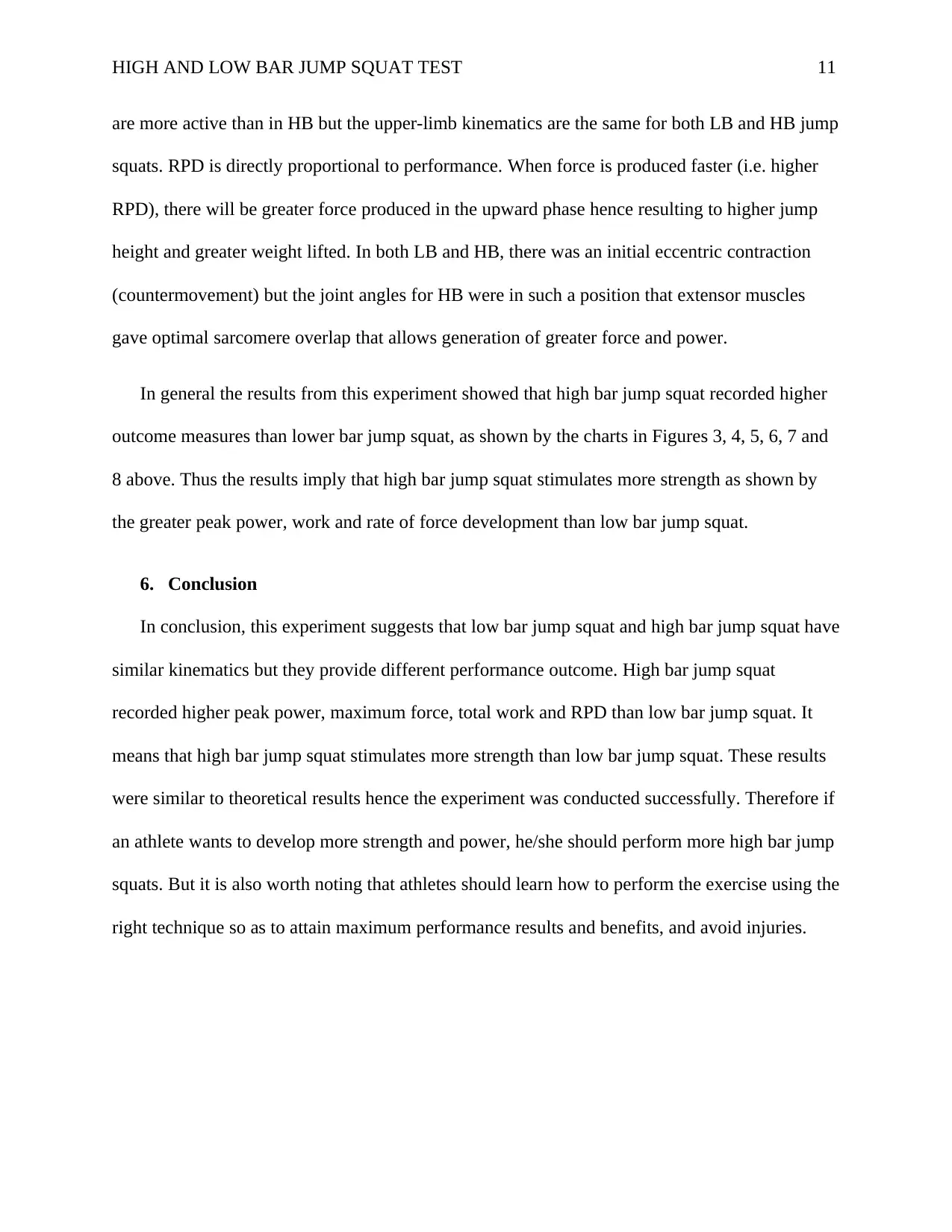
HIGH AND LOW BAR JUMP SQUAT TEST 11
are more active than in HB but the upper-limb kinematics are the same for both LB and HB jump
squats. RPD is directly proportional to performance. When force is produced faster (i.e. higher
RPD), there will be greater force produced in the upward phase hence resulting to higher jump
height and greater weight lifted. In both LB and HB, there was an initial eccentric contraction
(countermovement) but the joint angles for HB were in such a position that extensor muscles
gave optimal sarcomere overlap that allows generation of greater force and power.
In general the results from this experiment showed that high bar jump squat recorded higher
outcome measures than lower bar jump squat, as shown by the charts in Figures 3, 4, 5, 6, 7 and
8 above. Thus the results imply that high bar jump squat stimulates more strength as shown by
the greater peak power, work and rate of force development than low bar jump squat.
6. Conclusion
In conclusion, this experiment suggests that low bar jump squat and high bar jump squat have
similar kinematics but they provide different performance outcome. High bar jump squat
recorded higher peak power, maximum force, total work and RPD than low bar jump squat. It
means that high bar jump squat stimulates more strength than low bar jump squat. These results
were similar to theoretical results hence the experiment was conducted successfully. Therefore if
an athlete wants to develop more strength and power, he/she should perform more high bar jump
squats. But it is also worth noting that athletes should learn how to perform the exercise using the
right technique so as to attain maximum performance results and benefits, and avoid injuries.
are more active than in HB but the upper-limb kinematics are the same for both LB and HB jump
squats. RPD is directly proportional to performance. When force is produced faster (i.e. higher
RPD), there will be greater force produced in the upward phase hence resulting to higher jump
height and greater weight lifted. In both LB and HB, there was an initial eccentric contraction
(countermovement) but the joint angles for HB were in such a position that extensor muscles
gave optimal sarcomere overlap that allows generation of greater force and power.
In general the results from this experiment showed that high bar jump squat recorded higher
outcome measures than lower bar jump squat, as shown by the charts in Figures 3, 4, 5, 6, 7 and
8 above. Thus the results imply that high bar jump squat stimulates more strength as shown by
the greater peak power, work and rate of force development than low bar jump squat.
6. Conclusion
In conclusion, this experiment suggests that low bar jump squat and high bar jump squat have
similar kinematics but they provide different performance outcome. High bar jump squat
recorded higher peak power, maximum force, total work and RPD than low bar jump squat. It
means that high bar jump squat stimulates more strength than low bar jump squat. These results
were similar to theoretical results hence the experiment was conducted successfully. Therefore if
an athlete wants to develop more strength and power, he/she should perform more high bar jump
squats. But it is also worth noting that athletes should learn how to perform the exercise using the
right technique so as to attain maximum performance results and benefits, and avoid injuries.
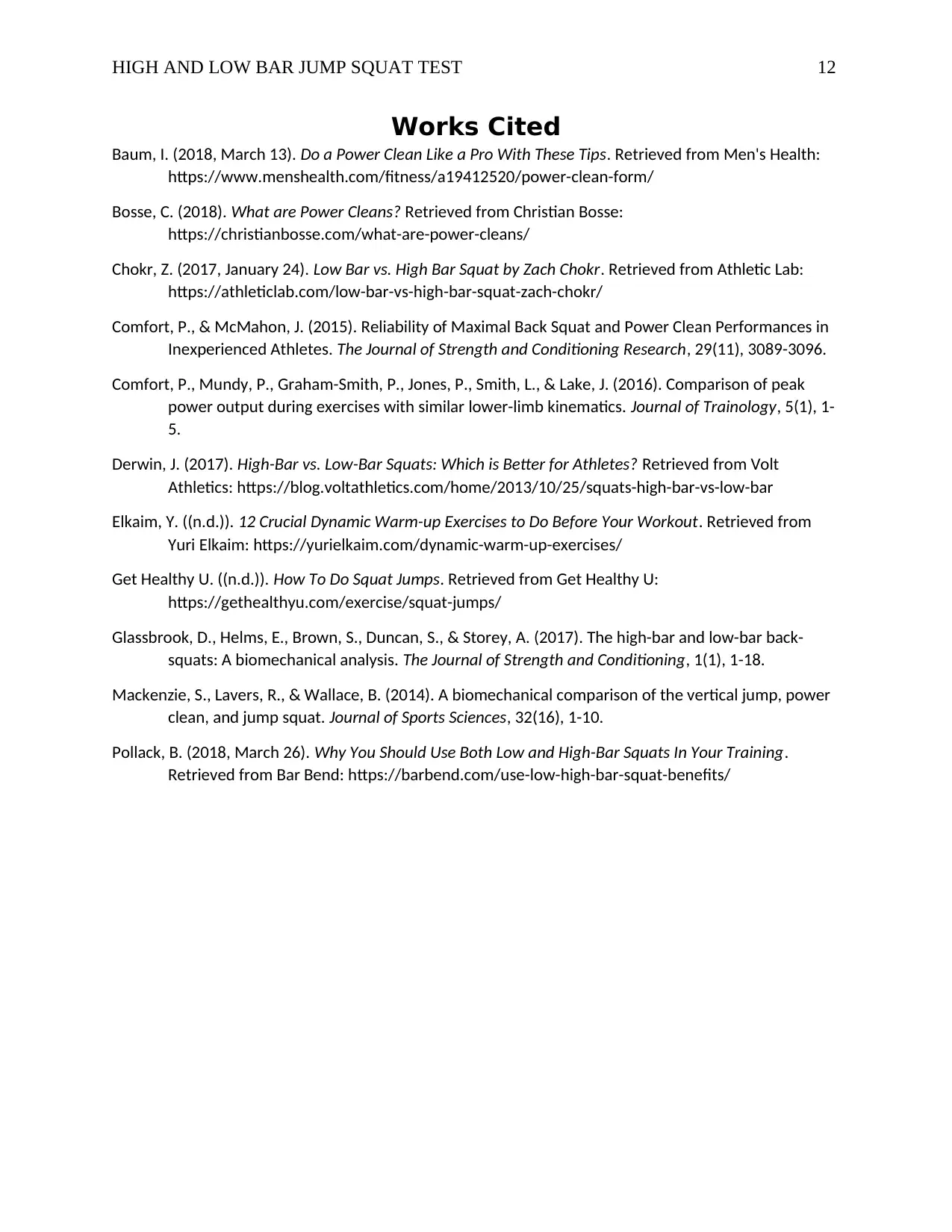
HIGH AND LOW BAR JUMP SQUAT TEST 12
Works Cited
Baum, I. (2018, March 13). Do a Power Clean Like a Pro With These Tips. Retrieved from Men's Health:
https://www.menshealth.com/fitness/a19412520/power-clean-form/
Bosse, C. (2018). What are Power Cleans? Retrieved from Christian Bosse:
https://christianbosse.com/what-are-power-cleans/
Chokr, Z. (2017, January 24). Low Bar vs. High Bar Squat by Zach Chokr. Retrieved from Athletic Lab:
https://athleticlab.com/low-bar-vs-high-bar-squat-zach-chokr/
Comfort, P., & McMahon, J. (2015). Reliability of Maximal Back Squat and Power Clean Performances in
Inexperienced Athletes. The Journal of Strength and Conditioning Research, 29(11), 3089-3096.
Comfort, P., Mundy, P., Graham-Smith, P., Jones, P., Smith, L., & Lake, J. (2016). Comparison of peak
power output during exercises with similar lower-limb kinematics. Journal of Trainology, 5(1), 1-
5.
Derwin, J. (2017). High-Bar vs. Low-Bar Squats: Which is Better for Athletes? Retrieved from Volt
Athletics: https://blog.voltathletics.com/home/2013/10/25/squats-high-bar-vs-low-bar
Elkaim, Y. ((n.d.)). 12 Crucial Dynamic Warm-up Exercises to Do Before Your Workout. Retrieved from
Yuri Elkaim: https://yurielkaim.com/dynamic-warm-up-exercises/
Get Healthy U. ((n.d.)). How To Do Squat Jumps. Retrieved from Get Healthy U:
https://gethealthyu.com/exercise/squat-jumps/
Glassbrook, D., Helms, E., Brown, S., Duncan, S., & Storey, A. (2017). The high-bar and low-bar back-
squats: A biomechanical analysis. The Journal of Strength and Conditioning, 1(1), 1-18.
Mackenzie, S., Lavers, R., & Wallace, B. (2014). A biomechanical comparison of the vertical jump, power
clean, and jump squat. Journal of Sports Sciences, 32(16), 1-10.
Pollack, B. (2018, March 26). Why You Should Use Both Low and High-Bar Squats In Your Training.
Retrieved from Bar Bend: https://barbend.com/use-low-high-bar-squat-benefits/
Works Cited
Baum, I. (2018, March 13). Do a Power Clean Like a Pro With These Tips. Retrieved from Men's Health:
https://www.menshealth.com/fitness/a19412520/power-clean-form/
Bosse, C. (2018). What are Power Cleans? Retrieved from Christian Bosse:
https://christianbosse.com/what-are-power-cleans/
Chokr, Z. (2017, January 24). Low Bar vs. High Bar Squat by Zach Chokr. Retrieved from Athletic Lab:
https://athleticlab.com/low-bar-vs-high-bar-squat-zach-chokr/
Comfort, P., & McMahon, J. (2015). Reliability of Maximal Back Squat and Power Clean Performances in
Inexperienced Athletes. The Journal of Strength and Conditioning Research, 29(11), 3089-3096.
Comfort, P., Mundy, P., Graham-Smith, P., Jones, P., Smith, L., & Lake, J. (2016). Comparison of peak
power output during exercises with similar lower-limb kinematics. Journal of Trainology, 5(1), 1-
5.
Derwin, J. (2017). High-Bar vs. Low-Bar Squats: Which is Better for Athletes? Retrieved from Volt
Athletics: https://blog.voltathletics.com/home/2013/10/25/squats-high-bar-vs-low-bar
Elkaim, Y. ((n.d.)). 12 Crucial Dynamic Warm-up Exercises to Do Before Your Workout. Retrieved from
Yuri Elkaim: https://yurielkaim.com/dynamic-warm-up-exercises/
Get Healthy U. ((n.d.)). How To Do Squat Jumps. Retrieved from Get Healthy U:
https://gethealthyu.com/exercise/squat-jumps/
Glassbrook, D., Helms, E., Brown, S., Duncan, S., & Storey, A. (2017). The high-bar and low-bar back-
squats: A biomechanical analysis. The Journal of Strength and Conditioning, 1(1), 1-18.
Mackenzie, S., Lavers, R., & Wallace, B. (2014). A biomechanical comparison of the vertical jump, power
clean, and jump squat. Journal of Sports Sciences, 32(16), 1-10.
Pollack, B. (2018, March 26). Why You Should Use Both Low and High-Bar Squats In Your Training.
Retrieved from Bar Bend: https://barbend.com/use-low-high-bar-squat-benefits/
⊘ This is a preview!⊘
Do you want full access?
Subscribe today to unlock all pages.

Trusted by 1+ million students worldwide
1 out of 13
Related Documents
Your All-in-One AI-Powered Toolkit for Academic Success.
+13062052269
info@desklib.com
Available 24*7 on WhatsApp / Email
![[object Object]](/_next/static/media/star-bottom.7253800d.svg)
Unlock your academic potential
Copyright © 2020–2025 A2Z Services. All Rights Reserved. Developed and managed by ZUCOL.





